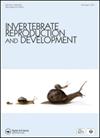Genesis and structure of eusperm and parasperm of Plicopurpura patula in relation to phylogeny of Neogastropoda: proteomics of parasperm suggests role in paternity assurance
IF 0.8
4区 生物学
Q4 REPRODUCTIVE BIOLOGY
引用次数: 0
Abstract
ABSTRACT Eusperm and parasperm ultrastructure have been studied for the first time in the neogastropod Plicopurpura patula. Eusperm structure is typical of many Neogastropoda, in which an apical bleb characterizes the conical acrosome with subacrosomal granule; the nucleus is tubular and penetrated to its tip by basal body and axoneme; the mid-piece comprises spiral mitochondria that ensheath the axoneme but terminate at the annulus, defining the junction with the end-piece. In the proximal portion of the end-piece dense tracts of glycogen match the axoneme but these disappear distally. The parasperm is unusual in having no axonemes and no motility was observed. Eusperm do not attach to parasperm, as occurs in the similar nurse cells of Littorinimorpha, thus potential functions may be limited to some form of paternity assurance as occurs in some insects. The nucleus of the parasperm is eliminated during paraspermiogenesis, but there is considerable post-transcriptional secretion activity resulting in the production of a variety of granules, some rich in glycoproteins. A prominent paracrystalline rod accumulates in the centre of the parasperm also from Golgi-derived secretions. Preliminary evidence from proteomics suggests that this parasperm carries the heat shock protein HSP70 that could play a role in fertilization inside the female.与新腹足动物系统发育有关的阔纹多齿目动物真胚和副胚的发生和结构:副胚的蛋白质组学表明其在父系鉴定中的作用
摘要首次研究了新腹足动物Plicopurpura patula的真胚和准胚超微结构。许多新腹足动物的胚乳结构是典型的,其顶体呈锥形,顶体下有小颗粒,顶端有一个尖泡;核呈管状,由基体和轴突穿透至核尖;中间部分包括螺旋形线粒体,包围轴突,但终止于环,定义与末端的连接处。在末端的近端,糖原密集束与轴索相匹配,但在远端消失。未观察到轴突和未观察到运动的超胚是不寻常的。原生质不像Littorinimorpha的类似哺乳细胞那样附着在副胚乳上,因此潜在的功能可能仅限于某些昆虫中出现的某种形式的父权保证。异胚乳的细胞核在异胚乳发生过程中被消除,但有相当大的转录后分泌活性,导致产生各种颗粒,其中一些富含糖蛋白。高尔基体衍生的分泌物也可在副胚乳中央积聚一突出的旁晶棒。来自蛋白质组学的初步证据表明,这种超胚携带热休克蛋白HSP70,可能在雌性体内的受精中发挥作用。
本文章由计算机程序翻译,如有差异,请以英文原文为准。
求助全文
约1分钟内获得全文
求助全文
来源期刊
CiteScore
1.90
自引率
0.00%
发文量
21
审稿时长
>12 weeks
期刊介绍:
Invertebrate Reproduction & Development ( IRD) presents original research on the reproductive and developmental biology of the Invertebrata, both embryonic and postembryonic. IRD welcomes papers reporting significant results obtained using new techniques. Encouraged topic areas include: aquaculture, physiology, biochemistry, functional morphology, phylogeny, behavioural and regulatory mechanisms, including genetic, endocrine and molecular studies. Papers containing qualitative descriptions of reproductive cycles and gametogenesis will not be considered. IRD is published in association with the International Society of Invertebrate Reproduction and Development.

 求助内容:
求助内容: 应助结果提醒方式:
应助结果提醒方式:


